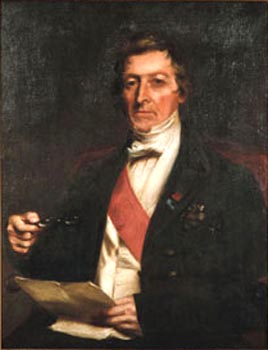Thomas Brisbane facts for kids
Quick facts for kids
Thomas Brisbane, 1st Bt
|
|
|---|---|

Painting of Thomas Brisbane by F. Schenck (1850)
|
|
| 6th Governor of New South Wales | |
| In office 1 December 1821 – 1 December 1825 |
|
| Monarch | George IV |
| Preceded by | Lachlan Macquarie |
| Succeeded by | Ralph Darling |
| Personal details | |
| Born | 23 July 1773 Largs, Ayrshire, Scotland |
| Died | 27 January 1860 (aged 86) Largs, Ayrshire, Scotland |
| Alma mater | University of Edinburgh |
| Military service | |
| Allegiance | United Kingdom |
| Branch/service | British Army |
| Rank | Major General |
| Battles/wars | Peninsular War War of 1812 |
| Awards | Knight Grand Cross of the Order of the Bath Knight Grand Cross of the Royal Guelphic Order Army Gold Cross |
Major General Sir Thomas Makdougall Brisbane, 1st Baronet (born 23 July 1773 – died 27 January 1860) was an important figure in British history. He was a brave British Army officer, a skilled administrator, and a passionate astronomer. He is best known for being the governor of New South Wales in Australia from 1821 to 1825.
Sir Thomas was recommended for the governor role by the Duke of Wellington, a famous military leader. As governor, Brisbane built the colony's second observatory and encouraged new ideas in science and farming. The city of Brisbane, now the third largest city in Australia, was named in his honour.
Contents
Early Life and Military Career
Thomas Brisbane was born in 1773 at Brisbane House in Noddsdale, Scotland. He studied astronomy and mathematics at the University of Edinburgh. In 1789, he joined the British Army and had a successful career. He fought in many places, including Europe and North America.
He served under the Duke of Wellington and became a major general in 1813. He was involved in the Peninsular War in Europe and the War of 1812 in North America. For his bravery and service, he received several important awards, including the Army Gold Cross.
In 1819, he married Anna Maria Hay Makdougall. After his father-in-law passed away, he added "Makdougall" to his name, becoming Thomas Makdougall Brisbane.
Governor of New South Wales
In 1821, Sir Thomas Brisbane became the Governor of New South Wales, a British colony in Australia. He started his role on December 1, 1821, and worked to improve the colony. He focused on making the land grant system better and reforming the money system.
Brisbane was very interested in science. He became the first President of the Philosophical Society of Australasia, which later became the Royal Society of New South Wales. He also started the first farming college in New South Wales and supported the New South Wales Agricultural Society. He even experimented with growing new crops like tobacco, cotton, and coffee.
One of his important changes was to the land grant system. He made it a rule that for every 100 acres given, the person receiving the land had to support one convict worker for free. He also made it easier for convicts to earn their freedom or receive pardons.
In 1823, Governor Brisbane sent Lieutenant John Oxley to find a new place for convicts who had re-offended. Oxley discovered a large river flowing into Moreton Bay. A year later, the first convicts arrived there. Brisbane visited the new settlement in December 1824. Oxley suggested naming both the river and the settlement after Governor Brisbane. The settlement became a town in 1834 and was opened for free settlers in 1839.
Brisbane faced some challenges during his time as governor, including disagreements with some of his officers. In 1824, he and his colonial secretary were recalled to England.
A Passion for Astronomy

Sir Thomas Brisbane was a dedicated astronomer throughout his life. He built an observatory at his home in Scotland in 1808. When he moved to New South Wales, he brought telescopes, books, and two astronomy assistants with him.
He had the first properly-equipped Australian observatory built at Parramatta. This observatory was important for recording stars in the southern hemisphere. One of its biggest achievements was the rediscovery of Encke's comet in 1822 by his assistant, Carl Ludwig Christian Rümker. When Brisbane left Australia, he left his astronomy equipment and books behind for the colony. Some of these items are still at the Sydney Observatory today.
Later Years and Legacy
Brisbane returned to Scotland in December 1825. He continued his scientific studies and built another observatory at his wife's estate. He was elected president of the Royal Society of Edinburgh in 1832 and was made a baronet in 1836. He was offered important military commands in Canada and India but chose to decline them.
Sir Thomas Brisbane was recognized for his contributions to science. He received the gold medal of the Royal Astronomical Society in 1828. In 1835, he published The Brisbane Catalogue, which listed 7,385 stars of the Southern Hemisphere. He also founded a gold medal for scientific research, awarded by the Royal Society of Edinburgh.
Sir Thomas Brisbane passed away on January 27, 1860, in Largs, Scotland. He is buried in the Brisbane family vault.
Many places and features are named after Sir Thomas Brisbane, honouring his important role in history and science:
- Brisbane, the capital city of Queensland, Australia.
- Brisbane River in Queensland, Australia.
- Brisbane, a crater on the Moon.
- Brisbane Street in several Australian cities like Hobart and Perth.
- Brisbane Water, an estuary in New South Wales.
- Sir Thomas Brisbane Planetarium, located in Brisbane, Queensland.
- Brisbane Glen, near his birthplace in Scotland.
- Isabella Plains, a suburb in Canberra, named after his daughter.
- The Makdougall Brisbane prize of the Royal Society of Edinburgh.
Images for kids
See also
 In Spanish: Thomas Brisbane para niños
In Spanish: Thomas Brisbane para niños
- Historical Records of Australia


